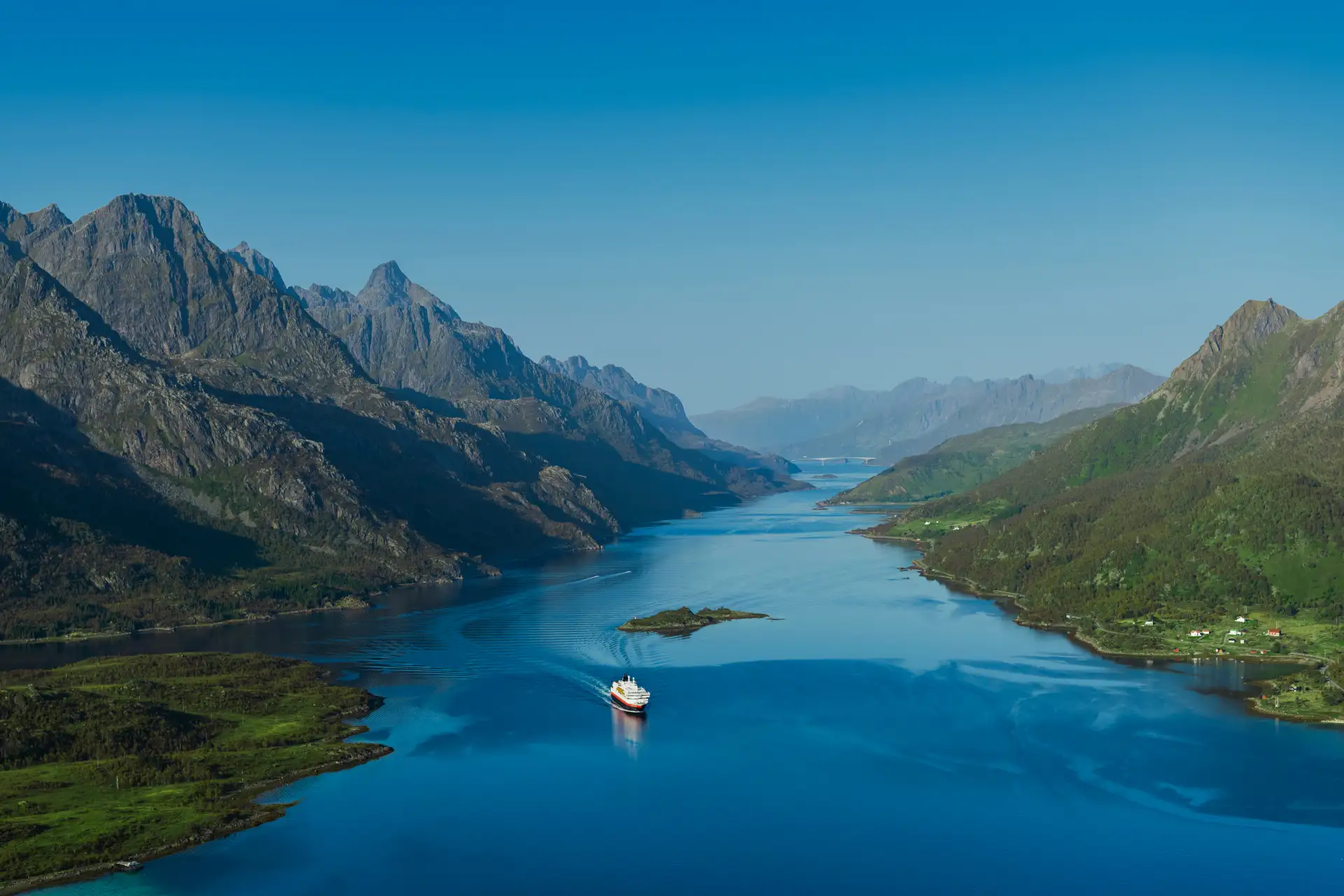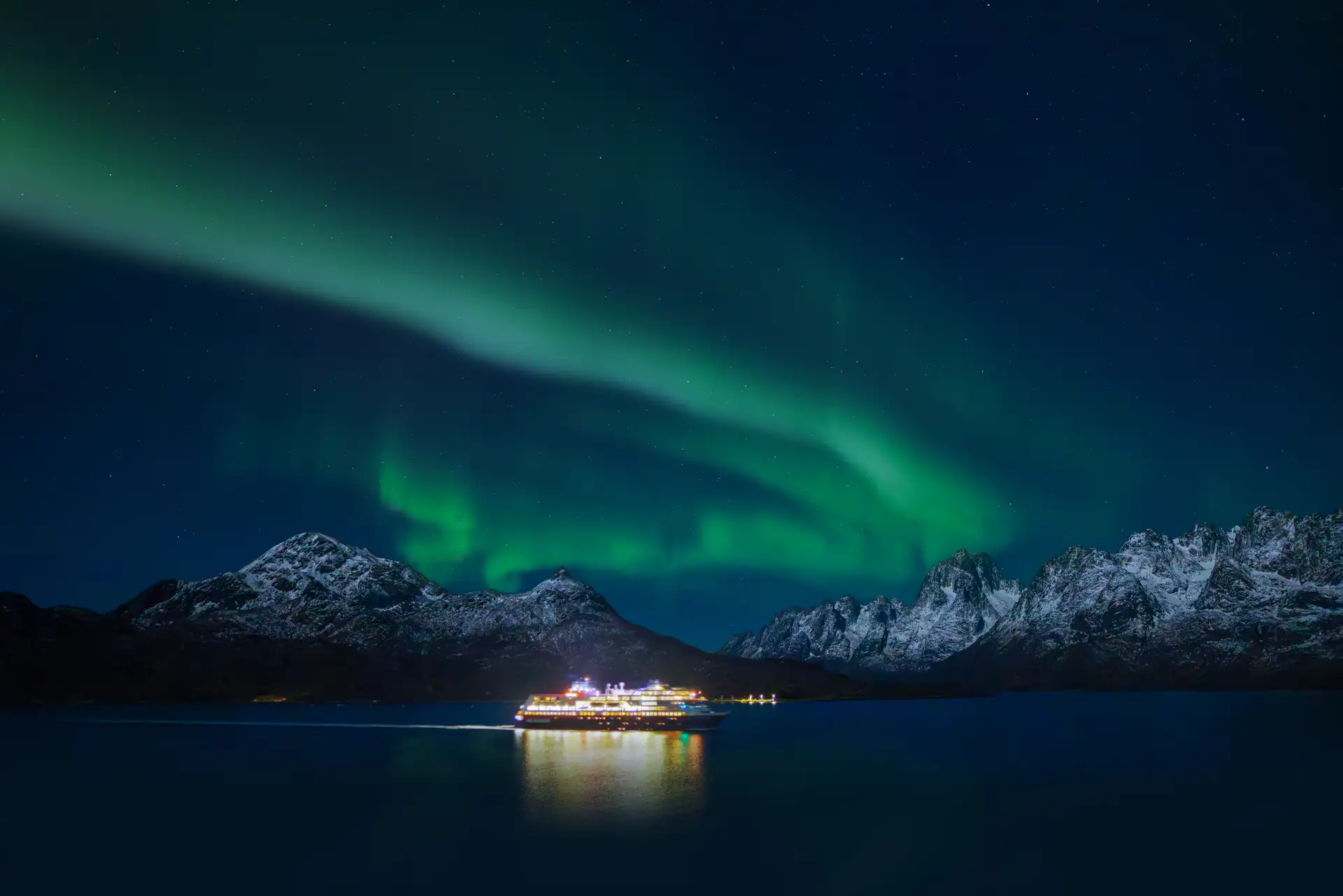Norwegian Fjords Cruises
Destination
Duration
Departure port
Ships
Year
Season
Offers
All voyages(39)

Bergen – Kirkenes – Bergen (Roundtrip)
The Coastal Express
The original Norwegian coastal voyage – connecting fjords, towns & people since 1893
Regular departures
12 days
34 Places
Full board

Kirkenes – Bergen (Southbound)
The Coastal Express – South
The southbound leg on our classic coastal voyage, exploring beautiful archipelagos & fjordlands
Regular departures
6 days
33 Places
Full board

Bergen – Kirkenes (Northbound)
The Coastal Express – North
The northbound leg of our classic coastal route, from Bergen to Arctic Norway
Regular departures
7 days
34 Places
Full board

Tromsø – Oslo (Southbound)
The North Cape Line - South
All-inclusive cruise south from Arctic Norway in winter, under the glow of the aurora
December 2025 - April 2027
9 days
8 Places
All-inclusive

Oslo - Honningsvåg - Oslo (Roundtrip)
The North Cape Line – Winter
All-inclusive winter cruise to Norway’s North Cape, chasing the Northern Lights
December 2025 - December 2027
15 days
13 Places
All-inclusive

Bergen – Kirkenes – Trondheim (Roundtrip)
The Coastal Express – To the Viking Capital
The original Norwegian coastal voyage, returning via Trondheim – home of Viking kings
Regular departures
11 days
34 Places
Full board

Oslo – Tromsø (Northbound)
The North Cape Line - North
All-inclusive Arctic cruise north along the Norwegian coast, with fjords & aurora views
December 2025 - April 2027
7 days
7 Places
All-inclusive

Oslo - Trondheim - Bergen - Oslo (Roundtrip)
Sail and Rail Norway
Rail & sea adventure through central Norway on The Coastal Express & Dovre Line
Regular departures
5 days
8 Places
Half board

Bergen - Svalbard - Bergen (Roundtrip)
The Svalbard Line
All-inclusive Arctic cruise to Svalbard & back, with fjords, wildlife & Midnight Sun
May 2026 - September 2027
15 days
14 Places
All-inclusive

Longyearbyen - Bergen (Southbound)
The Svalbard Line - South
All-inclusive cruise from the High Arctic exploring fjords, islands & wildlife
June - September 2026
8 days
9 Places
All-inclusive

Bergen – Longyearbyen (Northbound)
The Svalbard Line – North
All-inclusive Arctic cruise north to Svalbard, sailing fjords under the Midnight Sun
May - September 2026
8 days
7 Places
All-inclusive

Helsinki - Oslo (Southbound)
Savour the Northern Lights - Southbound
Escorted land & sea tour with all-inclusive cruise, igloo stay & husky safari
September 2026 - April 2027
15 days
7 Places
Full board

Oslo - Helsinki (Northbound)
Savour the Northern Lights - Northbound
Escorted land & sea tour with igloo stay, husky safari & all-inclusive cruise
September 2026 - April 2027
14 days
7 Places
Full board

Hamburg – Honningsvåg – Hamburg (Roundtrip)
The North Cape Line from Hamburg – Winter
All-inclusive German-speaking cruise to Norway’s far north in aurora season
December 2025 - April 2028
15 days
12 Places
All-inclusive

Hamburg – Honningsvåg – Hamburg (Roundtrip)
The North Cape Line – Summer
All-inclusive German-speaking cruise to Norway’s far north under the Midnight Sun
May 2026 - September 2027
15 days
12 Places
All-inclusive

Bergen - Ålesund - Trondheim - Bodø - Tromsø (Northbound)
West Fjords to the Arctic Capital
A short northbound sailing on our classic coastal route, through fjords to the Arctic
Regular departures
5 days
22 Places
No meals included

Tromsø - Brønnøysund - Trondheim - Bergen (Southbound)
Arctic Capital to the West Fjords
A short southbound sailing on our classic coastal route, through archipelagos & fjords
Regular departures
4 days
22 Places
No meals included

Bergen - Ålesund - Trondheim - Svolvær (Northbound)
West Fjords to Lofoten
A short Arctic-bound voyage on our historic coastal route, exploring fjords & islands
Regular departures
4 days
16 Places
No meals included

Svolvær - Brønnøysund - Trondheim - Bergen (Southbound)
Lofoten to the West Fjords
A short sailing south experiencing mountains, islands & UNESCO sites
Regular departures
4 days
16 Places
No meals included

Svolvær - Tromsø - Honningsvåg - Kirkenes (Northbound)
Lofoten to the Norwegian Border
A short Arctic voyage exploring Norway's far north & its remote beauty
Regular departures
4 days
19 Places
No meals included

Tromsø - Honningsvåg - Båtsfjord - Kirkenes (Northbound)
Arctic Capital to the Norwegian Border
Tromsø, the North Cape & Norway's eastern edge in one short voyage
Regular departures
3 days
13 Places
No meals included

Kirkenes - Hammerfest - Svolvær (Southbound)
Norwegian Border to Lofoten
A short voyage showing the beauty of Lofoten & Norway's north coast
Regular departures
3 days
17 Places
No meals included

Trondheim - Bodø - Tromsø (Northbound)
Viking Capital to the Arctic Capital
A classic short sailing crossing the Arctic Circle between two iconic Norwegian cities
Regular departures
3 days
15 Places
No meals included

Tromsø - Brønnøysund - Trondheim (Southbound)
Arctic Capital to the Viking Capital
From Arctic landscapes to Viking legacy on this short journey down Norway’s coast
Regular departures
3 days
15 Places
No meals included

Bergen - Ålesund - Trondheim (Northbound)
West Fjords to the Viking Capital
A short voyage exploring Art Nouveau gems & UNESCO-listed fjords
Regular departures
3 days
8 Places
No meals included

Trondheim - Kristiansund - Bergen (Southbound)
Viking Capital to the West Fjords
A two-day voyage through coastal communities, fjords & UNESCO highlights
Regular departures
2 days
8 Places
No meals included

Kirkenes - Hammerfest - Tromsø (Southbound)
Norwegian Border to the Arctic Capital
A two-day sailing showing the best of Norway’s spectacular northern coastline
Regular departures
2 days
12 Places
No meals included

Oslo - Bergen - Kirkenes - Bergen (Roundtrip)
Complete Norway – Midnight Sun
A summer cruise on our classic route, with Norway in a Nutshell & Flåm Railway
Regular departures
16 days
38 Places
Full board

Oslo - Bergen - Kirkenes - Bergen (Roundtrip)
Complete Norway – Northern Lights
Our classic voyage during aurora season, with Norway in a Nutshell & Flåm Railway
Regular departures
16 days
38 Places
Full board

Bergen - Tromsø (Northbound)
Culinary Voyage
A taste of Norway through fjords & farms on an adventure across land & sea
September - October 2026
7 days
Full board

Helsinki - Kirkenes - Bergen - Reykjavik (Southbound)
Grand Nordic Adventure – Finland, Norway & Iceland
Escorted land & sea tour including fjords, Blue Lagoon & Snowhotel visit
July 2026
19 days
8 Places
Full board

Oslo - Longyearbyen (Northbound)
Arctic Norway Frontier – Oslo, Fjords & Svalbard with cruise extension
80° North via one iconic train journey and two extraordinary sea voyages
May - August 2026
17 days
Full board

Oslo – Longyearbyen (Northbound)
Arctic Norway Frontier – Oslo, Fjords & Svalbard
Classic train ride & all-inclusive cruise taking in Norway & Svalbard
May - August 2026
13 days
Full board

Oslo - Kirkenes - Bergen - Flåm - Oslo (Roundtrip)
Best of Norway
Experience Oslo, the Flåm Railway & our classic coastal voyage on one seamless tour
Regular departures
12 days
8 Places
Full board

Oslo - Kirkenes - Bergen (Southbound)
Norway’s Capital & Coast
Escorted tour along the length of Norway, encompassing Oslo, the fjords & the Arctic
Regular departures
10 days
8 Places

Oslo-Kirkenes-Bergen-Oslo (Southbound)
Discover Norway with Summer Snowhotel Stay
Self-guided journey combining Arctic highlights, scenic cruising and urban exploration
Regular departures
10 days
34 Places
Full board

Oslo-Kirkenes-Bergen-Oslo (Southbound)
Discover Norway with Summer Arctic Cabin Adventure
Self-guided journey combining Arctic highlights, scenic cruising and urban exploration
Regular departures
10 days
Full board

Longyearbyen - Bergen (Southbound)
Arctic Norway Frontier - Svalbard, Fjords & Oslo
Svalbard wildlife, all-inclusive cruise and scenic rail
June - September 2026
13 days
Full board

Kirkenes - Bergen (Southbound)
A Nordic winter journey – Finnish Lapland, Norway and Oslo
Explore the Nordics by sled, sea and rail
December 2026 - March 2027
13 days